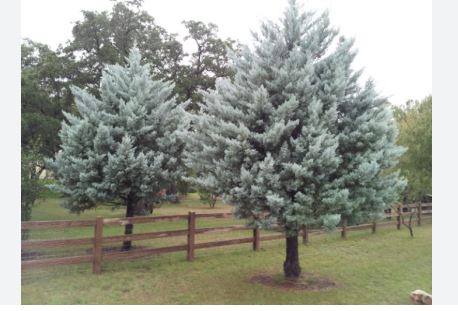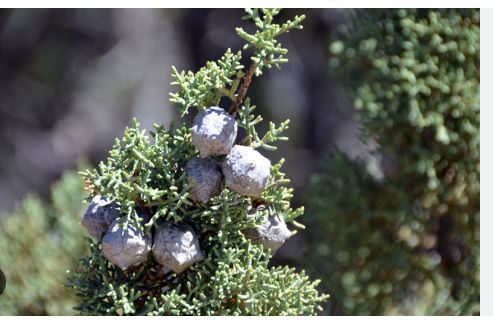
The Arizona Cypress (Hesperocyparis arizonica), a resilient evergreen conifer native to the southwestern United States and northern Mexico, is celebrated for its striking blue-green foliage, drought tolerance, and adaptability to arid environments. With its conical form and aromatic leaves, this tree is a favorite for xeriscaping, windbreaks, and ornamental landscapes, offering both aesthetic appeal and ecological benefits.
Its ability to thrive in harsh, dry conditions makes it a valuable species for sustainable gardening and habitat restoration. In this detailed guide, we explore the botanical classification, origin, identifying characteristics, habitat, distribution, USDA hardiness zones, and diverse uses of the Arizona Cypress.
Botanical Classification, Origin and Native Area
The Arizona Cypress, scientifically named Hesperocyparis arizonica, belongs to the Cupressaceae family, which encompasses cypresses, junipers, and cedars. Previously classified under the genus Cupressus, it was reclassified into Hesperocyparis based on genetic studies distinguishing New World cypresses from Old World species.
The species name arizonica reflects its association with Arizona, a key part of its native range. As a gymnosperm, it produces cones rather than flowers, and its closest relatives include other New World cypresses like the Monterey Cypress (Hesperocyparis macrocarpa) and Guadalupe Cypress (Hesperocyparis guadalupensis). Cultivars such as ‘Blue Ice’ and ‘Carolina Sapphire’ offer varied foliage colors and growth habits, enhancing its horticultural versatility.
The Arizona Cypress is native to the southwestern United States and northern Mexico, with its primary range spanning Arizona, New Mexico, western Texas, and southern Utah, as well as parts of Sonora, Chihuahua, and Coahuila in Mexico. It typically grows at elevations between 3,000 and 8,000 feet in mountainous regions, where it has adapted to arid, rocky environments.
Fossil records suggest cypresses were more widespread in North America millions of years ago, with Hesperocyparis arizonica evolving to thrive in the semi-arid Southwest. Indigenous peoples in the region used its wood for tools and construction, and its modern cultivation has expanded its presence far beyond its native highlands, particularly in xeriscaped landscapes.
Identifying Characteristics

The Arizona Cypress is a medium-sized conifer, typically growing 40–50 feet tall with a spread of 20–30 feet, though some specimens reach 70 feet in optimal conditions. Its conical to pyramidal crown is dense and symmetrical, becoming more open with age. The foliage consists of scale-like, blue-green to silvery-gray leaves, arranged in overlapping sprays, which emit a resinous, pleasant fragrance when crushed.
Cultivars like ‘Blue Ice’ feature striking silvery-blue foliage, while ‘Carolina Sapphire’ has a softer blue-green hue. The bark is smooth and reddish-brown when young, maturing to a gray, furrowed texture that peels in thin strips. The tree produces small, woody cones (0.5–1 inch), spherical to slightly oblong, with 6–8 scales and a bumpy surface, maturing from green to brown. Its drought-tolerant nature and colorful foliage make it a standout in arid landscapes.
Habitat
In its native habitat, the Arizona Cypress grows in semi-arid, mountainous regions, often on rocky slopes, canyons, and mesas with well-drained, gravelly, or sandy soils (pH 6.0–7.5). It thrives in full sun, requiring at least 6 hours of direct sunlight daily, and is highly tolerant of drought, heat, and poor soil conditions.
The tree is commonly found in mixed conifer woodlands alongside pines, junipers, and oaks, contributing to soil stabilization and erosion control on steep terrain. While it prefers dry environments, it can tolerate occasional moisture if drainage is excellent, as prolonged waterlogging leads to root rot. In cultivation, it adapts to urban and suburban settings, making it a popular choice for low-water landscapes and windbreaks.
Distribution
The Arizona Cypress is naturally distributed across the southwestern United States and northern Mexico, with significant populations in Arizona’s Santa Catalina and Huachuca Mountains, New Mexico’s Chisos Mountains, and Mexico’s Sierra Madre Occidental. Its range is limited to high-elevation, arid zones, where it forms scattered stands or small groves. Due to its ornamental appeal and drought tolerance, it has been widely planted beyond its native range, particularly in the western and southern United States, Australia, South Africa, and parts of southern Europe. It is not considered invasive but can naturalize in suitable dry climates. Conservation efforts focus on protecting its native habitats, which face threats from drought, fire, and land development.
USDA Hardiness Zones
The Arizona Cypress thrives in USDA Hardiness Zones 7–9, tolerating minimum temperatures from 0°F to 20°F (-18°C to -7°C). It is best suited to warm, dry climates with hot summers and mild winters, similar to its native Southwest. In Zone 7, young trees may require protection from severe frost, particularly in exposed sites, but mature specimens are hardy.
In warmer zones (8–9), it flourishes with minimal care, excelling in heat and low-water conditions. Its drought and wind tolerance make it ideal for xeriscaping and arid urban landscapes, though it may struggle in humid or poorly drained environments.
Uses
The Arizona Cypress is a versatile tree with significant ornamental, ecological, and practical applications. In landscaping, its conical form, colorful foliage, and drought tolerance make it a premier choice for xeriscaped gardens, privacy screens, windbreaks, and specimen trees. Cultivars like ‘Blue Ice’ and ‘Carolina Sapphire’ add vibrant color to desert landscapes, while compact forms suit smaller spaces or hedges.
Ecologically, it stabilizes soil on slopes, prevents erosion, and provides habitat for birds and small mammals in arid ecosystems. Its dense foliage offers wind protection, making it valuable for agricultural and residential windbreaks in dry regions. The tree’s aromatic, durable wood is used for small-scale crafts, fence posts, and furniture, though commercial harvesting is limited due to its slow growth and conservation status.
In urban settings, it enhances air quality and mitigates heat, thriving in low-maintenance landscapes. Culturally, the Arizona Cypress is valued in Southwestern landscapes for its connection to the region’s rugged beauty, symbolizing resilience in harsh environments. Its low water needs and aesthetic versatility make it a cornerstone of sustainable gardening.
Cultivation of Arizona Cypress (Hesperocyparis arizonica)
Climate Suitability: Arizona Cypress thrives in USDA Hardiness Zones 7–9, tolerating minimum temperatures from 0°F to 20°F (-18°C to -7°C). It prefers warm, dry climates with hot summers and mild winters, similar to its native Southwest. In Zone 7, protect young trees from severe frost to prevent foliage or root damage, while it flourishes effortlessly in warmer zones.
- Site Selection: Choose a location with full sun exposure, receiving at least 6–8 hours of direct sunlight daily, to promote dense foliage and vibrant color. The tree does not tolerate shade well, which can lead to sparse growth. Ensure the site allows for its mature size (40–50 feet tall, 20–30 feet wide) and is sheltered from excessive humidity or waterlogging.
- Soil Requirements: Plant in well-drained, gravelly, sandy, or loamy soil with a pH range of 6.0–7.5 (slightly acidic to neutral). Arizona Cypress excels in poor, rocky soils but is intolerant of heavy clay or waterlogged conditions, which cause root rot. Test soil drainage before planting and amend with sand or gravel if needed to improve aeration and drainage.
- Planting Time: The optimal planting seasons are early spring or fall, allowing roots to establish before summer heat or winter cold. Dig a hole twice as wide and as deep as the root ball, positioning the root collar at ground level. Backfill with native soil, tamp gently, and water thoroughly to settle the roots and eliminate air pockets.
- Watering Needs: Water young trees deeply once or twice weekly for the first 1–2 years to establish a strong root system, keeping soil moderately moist but not soggy. Once established, Arizona Cypress is highly drought-tolerant and requires minimal watering, except during extreme drought. Avoid overwatering, as excess moisture increases the risk of fungal diseases.
- Mulching: Apply a 2–3 inch layer of organic mulch (e.g., bark, wood chips) or inorganic mulch (e.g., gravel) around the base, extending to the drip line but keeping it 2 inches from the trunk. Mulch conserves soil moisture, regulates temperature, and suppresses weeds, supporting young trees in arid climates. Replenish mulch as needed to maintain effectiveness.
- Fertilization: Fertilize sparingly, as Arizona Cypress thrives in low-nutrient soils. In spring, apply a balanced, slow-release fertilizer (e.g., 10-10-10) to young trees to encourage growth, using half the recommended rate to avoid over-fertilization, which can cause weak, leggy growth. Mature trees rarely need supplemental feeding in native or well-prepared soils.
- Pruning: Prune minimally to maintain shape or remove dead, damaged, or crossing branches, ideally in late winter or early spring before new growth begins. Use clean, sharp shears for precise cuts. The tree’s natural conical form requires little shaping, but light trimming can enhance density for hedges or windbreaks, especially for cultivars like ‘Carolina Sapphire’.
- Pest and Disease Management: Monitor for pests such as spider mites, aphids, or cypress bark beetles, treating infestations with insecticidal soap or neem oil. The tree is susceptible to cypress canker (Seiridium cardinale), which causes branch dieback; improve air circulation, avoid overhead watering, and remove infected branches promptly to prevent spread. Proper drainage minimizes root rot risk.
- Spacing: Space trees 15–20 feet apart to accommodate their mature spread (20–30 feet), ensuring adequate sunlight and air circulation to reduce disease risk. For hedges or windbreaks, plant 6–10 feet apart, depending on the cultivar, to create a dense barrier. Consider their height (40–50 feet) when planting near structures or power lines.
- Wind Protection: Young Arizona Cypresses, with shallow roots, are vulnerable to wind damage in exposed, arid regions. Stake newly planted trees for the first 1–2 years using flexible ties to allow slight trunk movement, which strengthens roots. Remove stakes once the tree is established to promote independent growth and stability.
- Winter Care: In Zone 7 or colder microclimates, protect young trees from winter burn by wrapping them in burlap or applying an anti-desiccant spray to foliage. Ensure soil is moist before winter to prevent dehydration, as evergreens lose moisture through leaves in dry, cold conditions. Mature trees are frost-tolerant and require minimal winter care.
- Long-Term Growth: Arizona Cypresses grow moderately fast (1–2 feet per year) under optimal conditions, reaching 40–50 feet at maturity with a lifespan of 50–100 years. Their conical form, vibrant foliage, and drought tolerance make them ideal for xeriscaping, windbreaks, or ornamental planting in arid landscapes. Regular monitoring ensures health and structural integrity, especially in disease-prone regions.